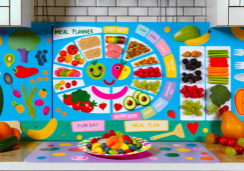What Does Simple Low-Carb Meal Planning Involve?
Have you ever wondered if the widely touted benefits of low-carb diets hold water when it comes to your daily meals?
As you embark on the journey of simple low-carb meal planning, you're committing to a lifestyle that prioritizes proteins and healthy fats while reducing your intake of sugars and starches.
You'll find yourself navigating the aisles for meats, leafy greens, and whole-food fats, sidestepping the siren calls of processed foods and carb-laden temptations.
It's not just about subtracting the bread and pasta; it's about understanding the balance of nutrients that keep you satiated and energized.
But the true art lies in transforming these components into delicious meals that won't leave you feeling deprived.
Stick with me, and you'll uncover how strategic meal prep can revolutionize your eating habits, simplify your routine, and perhaps even redefine what you consider a satisfying meal.
Understanding Low-Carb Diets
When considering a low-carb diet, it's essential to recognize that they vary widely, with daily carbohydrate limits ranging from a strict zero to a more moderate 150 grams. Low-carb diets focus on reducing your carb intake, often emphasizing proteins and fats to compensate for the restricted carbs and calories. This approach can help you lose weight and may be more sustainable than traditional calorie counting, as it often leads to reduced appetite.
It's important to understand that not all carbs are created equal. While low carb meal plans typically limit grains, sugars, and starchy vegetables, they encourage the consumption of nutrient-rich, low carb foods like leafy greens, nuts, and seeds. These foods provide essential vitamins and minerals, and their inclusion ensures that your eating low carb doesn't lead to nutritional deficiencies.
Moreover, evidence suggests that low carbohydrate diets can improve blood sugar levels, making them a potential strategy for those with diabetes or insulin resistance. By focusing on grams of carbs that come from high-quality sources, you're not just cutting out excess sugars—you're also making room for more nutrient-dense options.
Essential Low-Carb Foods
Building on the foundation of understanding low-carb diets, let's explore the essential low-carb foods that should form the cornerstone of your meal planning. These foods aren't only low in carbs but also rich in other vital nutrients, ensuring your low-carb meal plans are balanced and satisfying.
Your grocery list should feature:
- Non-starchy vegetables: Packed with vitamins and fiber, they're the backbone of low carb eating.
- *Cruciferous vegetables* like broccoli and cauliflower
- *Leafy greens* such as spinach and kale
Lean protein: Essential for muscle maintenance and satiety in your low carb meals.
- Fish, chicken, and eggs
- Greek yogurt for a probiotic boost
In addition, consider these low-carb companions:
- Bright and flavorful additions:
- Bell peppers, tomatoes, and cucumbers
- Hearty and versatile options:
- Zucchini and eggplant
- Mushrooms and asparagus
Each food group contributes to a symphony of flavors and benefits. By including a variety of these foods, you can create low carb meals that are nutrient-dense and enjoyable. Don't forget to sprinkle in some low carb snacks like nuts or cheese for added delight between meals. Remember, low-carb doesn't mean low-flavor or low-nutrition.
Structuring Your Meal Plan
To effectively structure your meal plan, you'll first want to establish your daily carb intake goal, ensuring it aligns with your health objectives and dietary needs. Typically, a Low Carb Meal Plan might entail consuming less than 130 grams of carbs or ensuring that carbs constitute no more than 20% of your total calories per day. This approach can be especially relevant for a diet for weight loss.
When creating your weekly eating plan, focus on integrating a variety of low-carb vegetables, lean proteins that provide essential grams of protein, and healthy fats. This balance is crucial to ensure you're getting the nutrients you need while maintaining a low intake of added sugar and high-carb foods. Aim to eat low-carb options that are rich in nutrients and fiber, helping you to feel full and satisfied.
As you monitor your daily macronutrient intake, make sure you're staying within your daily carb limit. This structured meal plan shouldn't only help with weight management but also stabilize blood sugar levels. To simplify meal preparation and guarantee nutritional adequacy, consider utilizing low-carb recipes and structured meal plans.
Prepping Low-Carb Meals
Having established your low-carb meal plan, it's essential to focus on the practical side of meal preparation to ensure you stick to your carb goals effectively. Low-carb diets require careful selection of foods, aiming for meals that contain less than 20% of calories from carbs. When you prepare your meals with intention, you're not just following low carb recipes; you're adopting an eating style that can revolutionize your health.
Choose nutrient-dense, healthy ingredients. Opt for low-carb options like broccoli, cauliflower, and leafy greens that are high in fiber and vitamins. Select lean meats, fish, or plant-based alternatives to maintain muscle and keep you satiated.
Monitor and adjust your intake. Use a food tracking app to log your meals and ensure you're within your carb limit. Consult with a registered dietitian for a personalized meal plan, especially if you're new to this eating style or have specific health concerns.
A systematic review of your eating habits will reveal the impact of careful meal prep. By keeping track of the grams of carbs, you empower yourself to make informed decisions that align with your health goals. Remember, each step in this journey is a stride towards a healthier you.
Navigating Challenges and Tips
Amidst the myriad of benefits that a low-carb diet offers, you'll also encounter challenges that require strategic navigation and a repertoire of practical tips to maintain this lifestyle successfully. When dining out, select meat-based dishes and hydrate with water to stay within your low-carb meal plan. Ask for extra veggies instead of carb-containing foods, scrutinize the menu ahead of time, and keep sauce portions in check to avoid hidden carbs.
Contrary to popular belief, cutting back on carbs doesn't mean you're destined for nutrient deficiencies or muscle loss. In fact, when you're focusing on low-carb eating, it's essential to ensure you're getting enough fiber, sodium, and not overdoing it with saturated fat to meet your dietary needs. Use the 101 low-carb recipes available as a guide; they're designed to be healthy, simple, and keep you on track without sacrificing flavor.
If you find yourself hungry between meals, prioritize nutrient-dense snacks to fuel your body. Be vigilant about reading labels and understanding the difference between low-carb and high-carb options. Remember, balance is key, and if you're uncertain about how to eat on a low-carb diet while meeting all your nutritional requirements, don't hesitate to seek professional guidance.
Frequently Asked Questions
How Do I Make a Low-Carb Diet Plan?
To make a low-carb diet plan, start with carb counting and macronutrient balance. Focus on meal prepping, ingredient swapping, and portion control. Do weekly shopping after recipe research and choose smart snack options and eating out.
What Are the Basics of a Low-Carb Diet?
You'll focus on nutrient-dense foods, balancing macronutrients, and choosing low glycemic index carbohydrate sources to manage insulin response and support keto adaptation. Carb cycling and sugar substitutes can optimize metabolic benefits and dietary fiber intake.
What Is an Example of a Popular Low-Carb Diet?
The ketogenic diet is a popular low-carb option, emphasizing fat adaptation and protein focus, while the Atkins approach allows phased carb cycling. Both prioritize nutrient-dense foods, akin to Paleo principles and Mediterranean twists.
What a Low-Carb Day Looks Like?
Your low-carb day prioritizes protein sources, includes smart snack ideas, and considers meal timing for nutrient balance. Stay hydrated, focus on fiber, choose sugar substitutes, and explore keto options when eating out.
Conclusion
In conclusion, you've got the tools for successful low-carb meal planning. Stock up on proteins, healthy fats, and non-starchy veggies to build satisfying meals.
Plan and prep ahead to keep on track, and don't let high-carb temptations derail your efforts. Stay flexible and find what works for you, ensuring a balanced approach for long-term health.
Remember, it's not just about cutting carbs but nourishing your body with the right nutrients for overall well-being.










